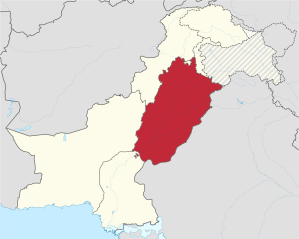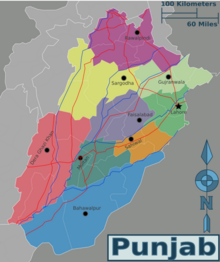Punjab (Pakistan)
| Emblem and flag | |||
|
|||
| Basic data | |||
|---|---|---|---|
| Capital : | Lahore | ||
| Status: | province | ||
| Area : | 205,344 km² | ||
| Residents : | 110,012,442 (2017 census) | ||
| Population density : | 535.7 inh / km² (2017) | ||
| ISO 3166-2 : | PK-PB | ||
| map | |||
Punjab and Punjab ( Punjabi and Urdu پنجاب) is the most populous province of Pakistan . It covers the Pakistani part of the greater Punjab landscape , has an area of 205,344 km² and, according to the 2017 census, 110,012,442 inhabitants (2017). The capital of Punjab is Lahore . More than half of the Pakistani population lives in the province.
geography
The Punjab province borders the Pakistani provinces of Sindh , Balochistan and Khyber Pakhtunkhwa - with it the Islamabad Capital Territory surrounds - to which semi-autonomous Asad Jammu and Kashmir as well as to the Indian union territory of Jammu and Kashmir and the Indian states of Punjab and Rajasthan (in a clockwise direction , starting in the southwest).
The provincial capital of Punjab is Lahore . Other important cities are Faisalabad , Rawalpindi , Multan and Gujranwala . Rivers from west to east are the Indus , Jhelam , Chanab , Ravi and the Satluj .
population
The most common mother tongues in Punjab are Punjabi with 75.2% of the population and Saraiki, which some consider to be a dialect of Punjabi, with 17.4% of the population. Another 4.5% speak Urdu as their mother tongue. (Data from the 1998 census).
97.2% of the population are Muslim , another 2.3% are Christians . Of the minorities of the Hindus (1941 census: 13.3%) and the Sikh (1941 census: other 11.9%), which were numerous before the partition of India and Punjab , only small remnants remained.
The literacy rate in 2014/15 among the population over 10 years of age was 63% (women: 55%, men: 71%), making it the highest among the 4 provinces of Pakistan.
Population development
Punjab census population since the first census in 1951.
| Census year | population |
|---|---|
| 1951 | 20,540,762 |
| 1961 | 25,463,974 |
| 1972 | 37,607,423 |
| 1981 | 47.292.441 |
| 1998 | 73.621.290 |
| 2017 | 110.012.615 |
economy
Punjab is the country's richest province and is responsible for a large part of the country's industrial production. Punjab has the highest literacy rate and the lowest poverty rate of all Pakistani provinces. With almost 40% of the population, it is also one of the most urbanized parts of the country. The north around the capital Lahore is considered to be significantly more prosperous than the backward south of the province. Important sectors are textile processing, construction and agriculture.
Due to the large demographic weight of the province, a large part of the state budget goes to the province of Punjab, triggering distribution struggles and fueling separatism in other regions of the country, especially in Balochistan and Sindh. Since the country was founded, the prosperity gap between Punjab Province and the rest of the country has grown steadily.
Administrative division
Divisions
The province is divided into 9 divisions, which in turn are divided into districts.
| No. | Divisions | Capital | Size (km²) |
Population (2017) |
|---|---|---|---|---|
| 1 | Bahawalpur | Bahawalpur | 45,588 | 11,464,031 |
| 2 | Dera Ghazi Khan | Dera Ghazi Khan | 38,778 | 11,014,398 |
| 3 | Faisalabad | Faisalabad | 17,917 | 14,177,081 |
| 4th | Gujranwala | Gujranwala | 17.206 | 16.123.984 |
| 5 | Lahore | Lahore | 16,104 | 19,398,081 |
| 6th | Multan | Multan | 21,137 | 12.265.161 |
| 7th | Rawalpindi | Rawalpindi | 22,255 | 10,007,821 |
| 8th | Sahiwal | Sahiwal | 10.302 | 7,380,386 |
| 9 | Sargodha | Sargodha | 26,360 | 8,181,499 |
Districts
There are 36 districts in Pakistan's Punjab Province
| No. | District | Capital | Size (km²) |
Population (2017) |
Density (inh / km²) |
division |
|---|---|---|---|---|---|---|
| 1 | Attock | Attock | 6,858 | 1,883,556 | 274 | Rawalpindi |
| 2 | Bahawalnagar | Bahawalnagar | 8,878 | 2,981,919 | 335 | Bahawalpur |
| 3 | Bahawalpur | Bahawalpur | 24,830 | 3,668,106 | 147 | Bahawalpur |
| 4th | Bhakkar | Bhakkar | 8,153 | 1,650,518 | 202 | Sargodha |
| 5 | Chakwal | Chakwal | 6,524 | 1,495,982 | 229 | Rawalpindi |
| 6th | Chiniot | Chiniot | 2,643 | 1,369,740 | 518 | Faisalabad |
| 7th | Dera Ghazi Khan | Dera Ghazi Khan | 11,922 | 2,872,201 | 240 | Dera Ghazi Khan |
| 8th | Faisalabad | Faisalabad | 5,856 | 7,873,910 | 1,344 | Faisalabad |
| 9 | Gujranwala | Gujranwala | 3,622 | 5,014,196 | 1,384 | Gujranwala |
| 10 | Gujrat | Gujrat | 3,192 | 2,756,110 | 863 | Gujranwala |
| 11 | Hafizabad | Hafizabad | 2,367 | 1,156,957 | 488 | Gujranwala |
| 12 | Jhang | Jhang | 8,809 | 2,743,416 | 311 | Faisalabad |
| 13 | Jhelam | Jhelam | 3,587 | 1,222,650 | 340 | Rawalpindi |
| 14th | Kasur | Kasur | 4,796 | 3,454,996 | 720 | Lahore |
| 15th | Khanewal | Khanewal | 4,349 | 2,921,986 | 671 | Multan |
| 16 | Khushab | Khushab | 6,511 | 1,281,299 | 196 | Sargodha |
| 17th | Lahore | Lahore | 1,772 | 11,126,285 | 6,278 | Lahore |
| 18th | Layyah | Layyah | 6,291 | 1,824,230 | 290 | Dera Ghazi Khan |
| 19th | Lodhran | Lodhran | 2,778 | 1,700,620 | 612 | Multan |
| 20th | Mandi Bahauddin | Mandi Bahauddin | 2,673 | 1,593,292 | 596 | Gujranwala |
| 21st | Mianwali | Mianwali | 5,840 | 1,546,094 | 264 | Sargodha |
| 22nd | Multan | Multan | 3,720 | 4,745,109 | 1,275 | Multan |
| 23 | Muzaffargarh | Muzaffargarh | 8,249 | 4,322,009 | 523 | Dera Ghazi Khan |
| 24 | Narowal | Narowal | 2,337 | 1,709,757 | 731 | Gujranwala |
| 25th | Nankana Sahib | Nankana Sahib | 2,960 | 1,356,374 | 458 | Lahore |
| 26th | Okara | Okara | 4,377 | 3,039,139 | 694 | Sahiwal |
| 27 | Pakpattan | Pakpattan | 2,724 | 1,823,687 | 669 | Sahiwal |
| 28 | Rahimyar Khan | Rahimyar Khan | 11,880 | 4,814,006 | 405 | Bahawalpur |
| 29 | Rajanpur | Rajanpur | 12,319 | 1,995,958 | 162 | Dera Ghazi Khan |
| 30th | Rawalpindi | Rawalpindi | 5,286 | 5,405,633 | 1,322 | Rawalpindi |
| 31 | Sahiwal | Sahiwal | 3,201 | 2,517,560 | 786 | Sahiwal |
| 32 | Sargodha | Sargodha | 5,854 | 3,703,588 | 632 | Sargodha |
| 33 | Sheikhupura | Sheikhupura | 5,960 | 3,460,426 | 580 | Lahore |
| 34 | Sialkot | Sialkot | 3,016 | 3,893,672 | 1,291 | Gujranwala |
| 35 | Toba Tek Singh | Toba Tek Singh | 3,252 | 2,190,015 | 673 | Faisalabad |
| 36 | Vehari | Vehari | 4,364 | 2,897,446 | 663 | Multan |
history
With the partition of India in 1947, the larger western part of Punjab with the capital Lahore became part of the new state of Pakistan. This division resulted in civil war-like conditions: Hindus fled to the east and Muslims to the west. Both sides carried out numerous massacres of the other group over several weeks.
Web links
Individual evidence
- ↑ Population and Statistics of Pakistan
- ↑ a b Pakistan Bureau of Statistics | 6th Population and Housing Census. Retrieved November 9, 2017 .
- ^ Pakistan Bureau of Statistics (2016). Pakistan Social and Living Standards Measurement Survey 2014–2015. Government of Pakistan, accessed June 29, 2019 .
- ↑ Northern Punjab, urban Sindh people more prosperous than rest of country: report - The Express Tribune . In: The Express Tribune . June 20, 2016 ( com.pk [accessed April 2, 2018]).
Coordinates: 31 ° 0 ' N , 72 ° 0' E






